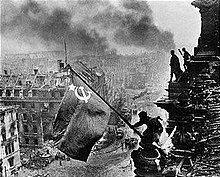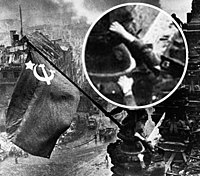add source |
Moscow Connection (talk | contribs) Undid revision 493726112 by Esemono (talk) I have to undo this, the source says that smoke was "hinzugemogelt", which means "added". |
||
| Line 7: | Line 7: | ||
==Background== |
==Background== |
||
[[File:Soviet flag on the Reichstag roof Khaldei.jpg|thumb|''Raising a flag over the Reichstag'', by [[Yevgeny Khaldei]] but with smoke enhanced{{ |
[[File:Soviet flag on the Reichstag roof Khaldei.jpg|thumb|''Raising a flag over the Reichstag'', by [[Yevgeny Khaldei]] but with smoke enhanced{{citation needed|date=May 2012}}]] |
||
{{Main|Battle of Berlin}} |
{{Main|Battle of Berlin}} |
||
The [[Battle of Berlin]] was the final major [[Offensive (military)|offensive]] of the [[European Theatre of World War II|European Theatre]] of World War II and was designated the Berlin Strategic Offensive Operation by the [[Soviet Union]].<ref name="LastOffensive" group="A" /> Starting on 16 January 1945, the Red Army breached the [[Nazi Germany|German]] front as a result of the [[Vistula–Oder Offensive]] and rapidly advanced westward through Germany, as fast as 30–40 kilometres a day. The [[Battle in Berlin|battle for Berlin]] lasted from late 20 April 1945 until 2 May and was one of the [[List of battles by casualties#Sieges and urban combat|bloodiest]] in history. As Berlin fell, Red Army [[War photography|photographer]] [[Yevgeny Khaldei]] gathered some soldiers together in the hope of getting a defining photograph like the American [[Raising the Flag on Iwo Jima|Iwo Jima flag picture]]. |
The [[Battle of Berlin]] was the final major [[Offensive (military)|offensive]] of the [[European Theatre of World War II|European Theatre]] of World War II and was designated the Berlin Strategic Offensive Operation by the [[Soviet Union]].<ref name="LastOffensive" group="A" /> Starting on 16 January 1945, the Red Army breached the [[Nazi Germany|German]] front as a result of the [[Vistula–Oder Offensive]] and rapidly advanced westward through Germany, as fast as 30–40 kilometres a day. The [[Battle in Berlin|battle for Berlin]] lasted from late 20 April 1945 until 2 May and was one of the [[List of battles by casualties#Sieges and urban combat|bloodiest]] in history. As Berlin fell, Red Army [[War photography|photographer]] [[Yevgeny Khaldei]] gathered some soldiers together in the hope of getting a defining photograph like the American [[Raising the Flag on Iwo Jima|Iwo Jima flag picture]]. |
||
Revision as of 22:13, 21 May 2012
Raising a flag over the Reichstag is a historic World War II photograph taken during the Battle of Berlin on 2 May 1945, by Yevgeny Khaldei. It depicts several Soviet troops raising the flag of the Soviet Union atop the German Reichstag building. The photograph was instantly popular, being reprinted in thousands of publications. It came to be regarded around the world as one of the most significant and recognizable images of the war.
The identities of the men in the picture were often disputed, also that of the photographer (Khaldei), who was only identified after the fall of the Soviet Union. The photograph is full of symbolism and represents a historic moment.
Erected in 1894, the Reichstag's architecture was magnificent for its time. The building contributed much to German history and was considered by the Red Army the symbol of their enemy. In reality, the Reichstag had not been used for any official purposes since the 1933 fire and had never been fully repaired. After very bloody and fierce combat within its walls, the Soviets finally captured the Reichstag on 2 May 1945, drawing closer to the end a war that had cost the lives of many millions of Germans and Soviets.
Background

The Battle of Berlin was the final major offensive of the European Theatre of World War II and was designated the Berlin Strategic Offensive Operation by the Soviet Union.[A 1] Starting on 16 January 1945, the Red Army breached the German front as a result of the Vistula–Oder Offensive and rapidly advanced westward through Germany, as fast as 30–40 kilometres a day. The battle for Berlin lasted from late 20 April 1945 until 2 May and was one of the bloodiest in history. As Berlin fell, Red Army photographer Yevgeny Khaldei gathered some soldiers together in the hope of getting a defining photograph like the American Iwo Jima flag picture.
Taking the photo
The events surrounding the flag-raising are murky due to the confusion of the battle to take the number one target in Berlin, the Reichstag. On 30 April there was great pressure to take the building, (seen as symbolic and at the heart of the "fascist beast"), before May Day.[1] Initially, two planes dropped several large red banners on the roof that appeared to have caught on the bombed-out dome. Additionally a number of reports had reached headquarters that two parties, M.M. Bondar from the 380th Rifle Regiment and Captain V.N. Makov of the 756th might have been able to hoist a flag during the day of 30 April.[2] These reports were received by Marshal G.K. Zhukov who issued an announcement stating that his troops had captured the Reichstag and hoisted a flag. However, when correspondents arrived they found no Soviets in the building but were in fact pinned down outside by German fire. After fierce fighting a flag was raised at 10:40 PM on 30 April 1945 when 23-year old Mikhail Minin climbed the building and inserted a flag into a mounted statue's (Germania's), crown. As this happened at night, it was too dark to take a photograph.[3] The next day the flag was taken down by the Germans.[3] The Red Army finally controlled the entire building on 2 May.[4]
On 2 May 1945 Khaldei scaled the now pacified Reichstag to take his picture. The official story would later be that two hand-picked soldiers: a Georgian, Meliton Kantaria[A 2] (allegedly selected to please Stalin who was also Georgian) and a Russian, Mikhail Yegorov, raised the Soviet flag over Reichstag,[A 3][1][6][7][8] and the photograph would be often used as depicting the event. However, some authors state that for political reasons the subjects of the photograph were changed and the actual man to hoist the flag was Alyosha Kovalyov,[A 4][9][10] a Ukrainian, who was told by the NKVD to keep quiet about it.[9] According to Khaldei himself, when he arrived to the Reichstag, he simply asked the soldiers who happened to be passing by to help with staging of the photoshoot;[11][12] there were only four of them, including Khaldei, on the roof:[13] the one who was attaching the flag was 18-year-old Private Alexei Kovalyov from Kiev, the two others were Abdulkhakim Ismailov from Dagestan and Leonid Gorychev from Minsk.[12][13][14]
Aftermath
The photo was published 13 May 1945 in the Ogonyok magazine.[5] While many photographers took pictures of flags on the roof, it was Khaldei's image that stuck.[5]
Image censored
After taking the symbolic photo, Khaldei quickly returned to Moscow. He further edited the image at the request of the editor-in-chief of the Ogonyok, who noticed that Sen. Sgt. Abdulkhakim Ismailov, who is supporting the flag-bearer was wearing two watches, which could imply he had looted one of them.[5] Using a needle, he was able to remove the watch from the right wrist.[15][5] He also copied the smoke in the background from another picture to make the scene more dramatic.[15]
See also
Annotations
- ^ The last offensive of the European war was actually the Prague Offensive on 6–11 May 1945, when the Red Army, with the help of Polish, Romanian, and Czechoslovak forces defeated the parts of Army Group Center which continued to resist in Czechoslovakia. There were a number of minor battles and skirmishes involving small bodies of men, but no other large scale fighting that resulted in the death of thousands of people, (see The end of World War II in Europe for details on these final days of the war).
- ^ Alternately spelled: Kantariya, M. V. Kantaria, Meliton Kantaria
- ^ Alternately spelled: M. V. Yegorov, M. A. Yegorov, Mikhail Iegorev
- ^ Alternately spelled: Aleksei Kovalev
Bibliography
- Notes
- ^ a b Dallas 2006, p. 3.
- ^ Tissier 1999, p. 168.
- ^ a b Lucas 2010.
- ^ Beevor 2003, pp. 390–397.
- ^ a b c d e Sontheimer 2008.
- ^ Tissier 1999, p. 124.
- ^ Antill & Dennis 2005, p. 76.
- ^ Adams 2008, p. 48.
- ^ a b Broekmeyer 2004, p. 130.
- ^ Walkowitz & Knauer 2004, p. 83.
- ^ "Legendäre Foto-Manipulation Fahne gefälscht, Uhr versteckt, Wolken erfunden - SPIEGEL ONLINE" (in German). Spiegel. 2008-05-06. Retrieved 2012-05-20.
- ^ a b "Remembering a Red Flag Day". Time. 2008-05-23. Retrieved 2012-05-20.
- ^ a b "«Знамя Победы над Рейхстагом». Сенсационная история фото" (in Russian). The Epoch Times. 2006-05-08. Retrieved 2012-05-20.
- ^ "Prominent Russians: Yegorov and Kantaria". Russia Today. Retrieved 2012-05-20.
- ^ a b Baumann 2010.
- References
- Adams, Simon (2008). The Eastern Front (2008 ed.). The Rosen Publishing Group. ISBN 1-4042-1862-9.
{{cite book}}: Invalid|ref=harv(help) – Total pages: 48 - Antill, Peter; Dennis, Peter (2005). Berlin 1945: End of the Thousand Year Reich (when ed.). Osprey Publishing. ISBN 1-84176-915-0.
{{cite book}}: Invalid|ref=harv(help) – Total pages: 96 - Baumann, Von Doc (2010-01-03). "Dramatische Rauchwolcken" (in German). Der Spiegel. Retrieved 2011-06-03.
{{cite web}}: Invalid|ref=harv(help) - Beevor, Antony (2003). Berlin: The Downfall 1945. Penguin Books. ISBN 067003041.
{{cite book}}: Check|isbn=value: length (help); Invalid|ref=harv(help) - Broekmeyer, M. J. (2004). Stalin, the Russians, and their war: 1941-1945 (2004 ed.). University of Wisconsin Press. ISBN 0-299-19594-5.
{{cite book}}: Invalid|ref=harv(help) – Total pages: 315 - Conquest, Robert (1991). The Great Terror: A Reassessment (1991 ed.). Oxford University Press US. ISBN 0-19-507132-8.
{{cite book}}: Invalid|ref=harv(help) – Total pages: 584 - Dallas, Gregor (2006). 1945: The War That Never Ended (2006 ed.). Yale University Press. ISBN 0-300-11988-7.
{{cite book}}: Invalid|ref=harv(help) – Total pages: 792 - Lenin, Vladimir (1929). Collected Works, Volume XX (1929 ed.). International Publishers. ISBN 1-4179-1577-3.
{{cite book}}: Invalid|ref=harv(help) - Lindemann, Albert S. (2000). Esau's Tears: Modern anti-semitism and the rise of the Jews (2000 ed.). Cambridge University Press. ISBN 0-521-79538-9.
{{cite book}}: Invalid|ref=harv(help) – Total pages: 568 - Lucas, Dean (2010-02-28). "Flag on the Reichstag". FamousPictures.org. Retrieved 2011-06-03.
{{cite web}}: Invalid|ref=harv(help) - Sontheimer, Michael (2008-07-05). "The Art of Soviet Propaganda: Iconic Red Army Reichstag Photo Faked". Der Spiegel. Retrieved 2011-06-03.
{{cite web}}: Invalid|ref=harv(help) - Tissier, Tony Le (1999). Race for the Reichstag: the 1945 Battle for Berlin (1999 ed.). Routledge. ISBN 0-7146-4929-5.
{{cite book}}: Invalid|ref=harv(help) – Total pages: 265 - Walkowitz, Daniel J.; Knauer, Lisa Maya (2004). Memory and the impact of political transformation in public space Radical perspectives (when ed.). Duke University Press. ISBN 0-8223-3364-3.
{{cite book}}: Invalid|ref=harv(help) – Total pages: 326 - "За него Геринг получил по шее". Interview (in Russian). Nizhny Novgorod: Moskovskij Komsomolets. 2010-05-12. Retrieved 2011-06-03.
{{cite web}}: Unknown parameter|trans_title=ignored (|trans-title=suggested) (help) - "Iconic WWII photo honored at Berlin exhibit". Associated Press. USA Today. 2008-06-15*. Retrieved 2012-05-20.
{{cite web}}: Check date values in:|date=(help) - "Iconic WWII photo staged". Associated Press. USA Today. 2008-06-16. Retrieved 2012-05-20.
- "The Art of Soviet Propaganda Iconic Red Army Reichstag Photo Faked - SPIEGEL ONLINE". Spiegel. 2008-05-07. Retrieved 2012-05-20.
- "Muere el último sobreviviente de la foto más famosa del fin de la II Guerra" (in Spanish). La Tercera. 2010-02-18. Retrieved 2012-05-20.
- "Soviet soldier pictured in iconic 1945 Reichstag photo dies". Associated Press. Guardian. 2010-02-17. Retrieved 2012-05-20.
